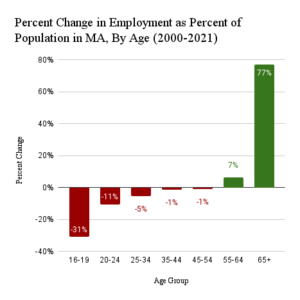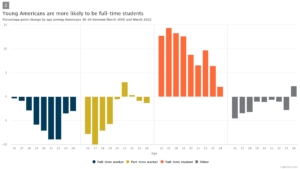State, Regional, and National Employment Trends Point to an Aging Workforce: Part Two
As explained in Part One, Massachusetts, New England, and the United States at large have seen increasing employment among those aged 65 and older in recent years. Variables contributing to the increased employment include changes made to raise the eligibility age for full retirement benefits and increase the delayed retirement credit, losses in retirement funds due to the Great Recession, and high inflation rates, all of which encourage delaying retirement as long as possible.

Fig. 1. Data Source for Analysis: Labor Analytics and U.S. Bureau of Labor Statistics
Meanwhile, young people are working at lower rates than ever, as can be discerned by the percent decrease in employment for each age category younger than 55 between 2000-2021 in Figure 1. Most notably, those aged 16-19 experienced over a 30% decrease, while those aged 20-24 had over a 10% decrease.
This trend is partly influenced by young peoples’ increasing likelihood to be in school today. For instance, Artem Gulish, who works with the Georgetown University Center on Education and the Workforce, stated that, “‘Physical skills that once allowed many young people…to go into the manufacturing sector have declined in demand from employers…[and]…has resulted in a significant increase in the return to education…’” (Source: Minneapolis Fed). Over the past two decades alone, young people have become more likely to be full-time students, while there have been observed percent decreases in those choosing to work full time, especially those who are the typical college ages of 18-22.
This shift can be attributed to “degree inflation” in the United States, which author Kate Morgan defines as “the rising demand for Bachelor’s degrees in jobs that didn’t always require one, and probably don’t actually require one now” (Source: BBC). A Bachelor’s degree has become a gold standard for employment in the United States despite the fact that many of those currently working the same positions did not need one to do their jobs.
Young people have turned to receiving at least a Bachelor’s degree before they enter the workforce, so as to make themselves more likely to be offered positions, as well as to enhance promotion mobility once they are employed. This takes away from the time young people have available to work; hence, educational requirements for working have contributed to lower employment levels for this population.

Fig. 5. Source: Minneapolis Fed
One key implication of the aging workforce is that as older workers leave their jobs due to declining health or retirement, there will need to be a transfer of knowledge to younger workers. Companies should develop plans to facilitate this transfer before it is too late, and institutional knowledge is lost. Otherwise, productivity will likely suffer.
It is also important to note that those who are currently near-retirement or at retirement age are members of the Baby Boom generation, as all will have turned 65 by 2030. The Baby Boom generation is very large, which could indicate that the members reaching retirement age would lead to mass labor shortages, as they begin to retire or leave the workforce.
However, the younger Millennial generation has become increasingly populous in the past few years due to immigration influxes, which could help offset these shortages. According to the Brookings Institution, “the combined millennial, Gen Z, and younger generations numbered 166 million as of July 2019, or 50.7% of the nation’s population…” Thus, the majority of the population in the U.S. is either a Millennial or Gen Z, meaning that they are 42 years or younger. By 2030 when the populous Baby Boom generation will all be 65 years or older, the Millennial and Gen Z generations, which have overtaken the Baby Boomers in population, must fill their roles to avoid labor shortages.
About the Author: Sarah Delano is a Roger Perry Government Transparency Intern at the Pioneer Institute for the summer of 2023. She is a senior studying Political Science at the University of Massachusetts-Amherst.



